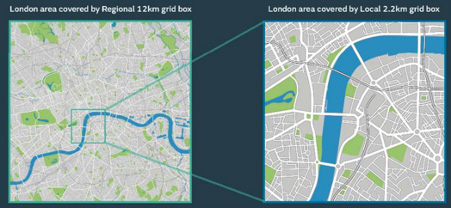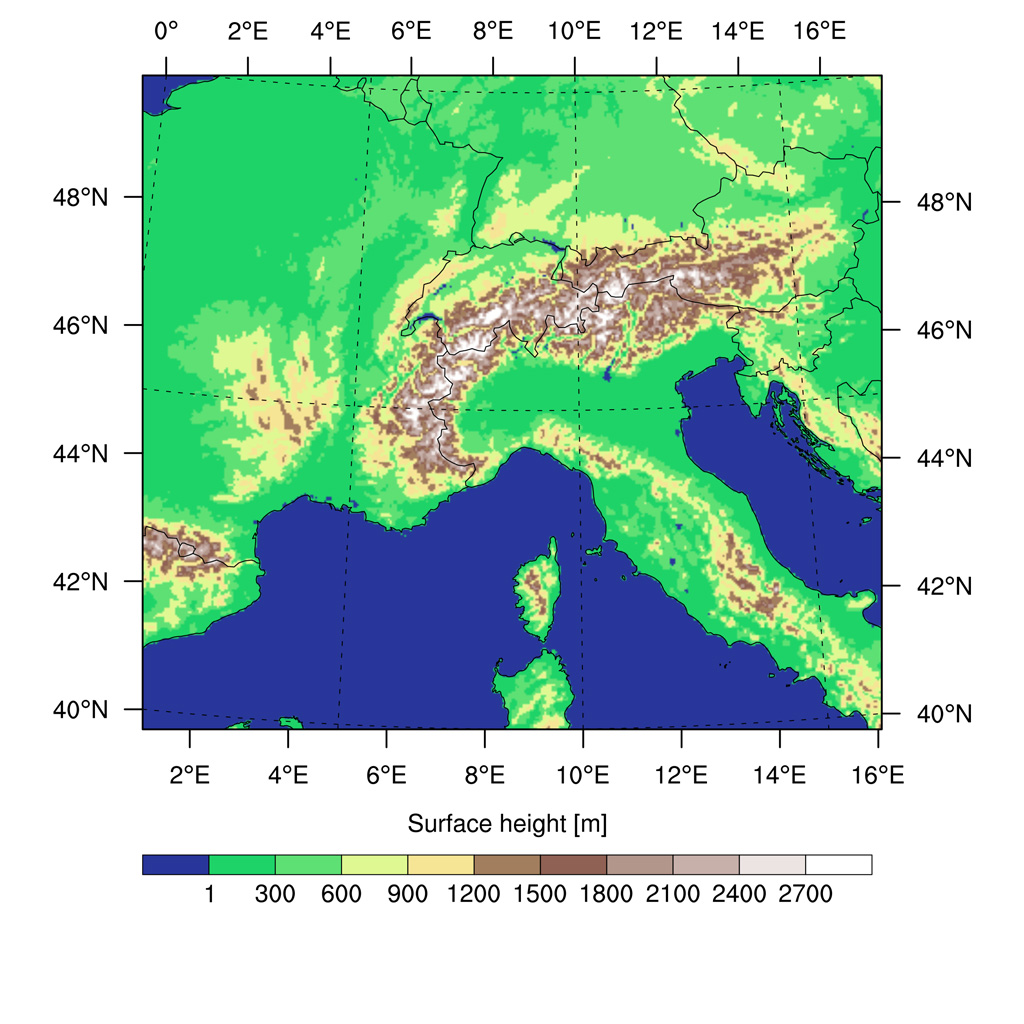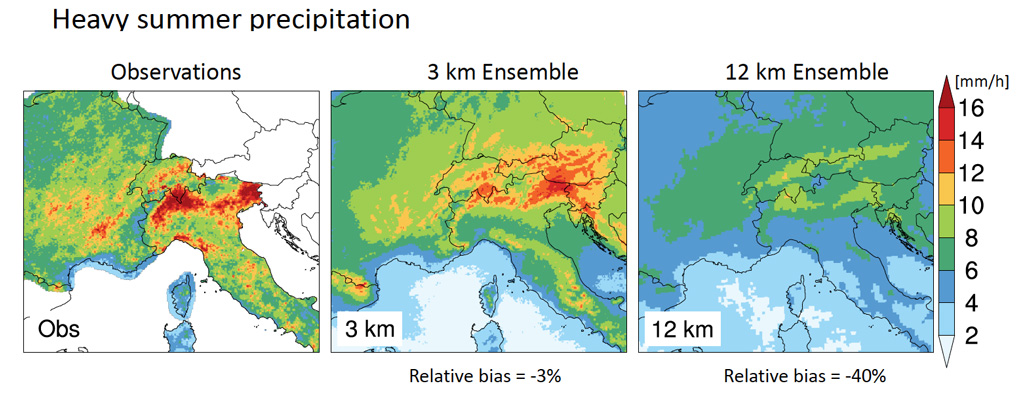
Guest post: How ‘high-resolution’ climate models will help Europe plan for extreme weather

Guest authors
04.12.21
Guest authors
12.04.2021 | 2:51pm“Convective” storms cause some of Earth’s most dramatic weather, including extreme rainfall, hail, lightning and severe wind gusts. Along with lighting up the skies, these storms frequently cause catastrophic damage. In Europe, for example, the costs run to billions of euros every year.
Scientists expect that the frequency and intensity of convective storms will change as the climate warms. And understanding these changes is crucial to ensuring the resilience of critical infrastructure to extreme weather.
However, accurate projections of convective weather require “high-resolution” climate models. Yet climate services often lack such detailed data and are typically built on the coarse climate model output available.
As a result, adaptation planning – regarding, for example, urban flood management, hail damage to solar panels and crops, and lightning impact on electricity networks – are often left to crude assumptions.
Fortunately, a new generation of climate models – known as “convection-permitting models” (CPMs) – are providing a step change in our ability to project changes in high-impact weather extremes.
In a pair of new papers, published in Climate Dynamics, we show how recent advances in the use of CPMs are bringing about a step change in the information available for climate change risk assessment in Europe.
High resolution models
In order to simulate the Earth’s climate, a model divides up the Earth’s surface and overlying atmosphere into a giant grid. The model then calculates climate variables, such as temperature, humidity and rainfall, for each grid cell.
Global models typically have grid spacings of the order of 10-100km. Modellers have to find a balance between the added detail of smaller grid cells with the greater computing power that higher resolution models require to run.
“Convection-permitting models” (CPMs) are very high-resolution models of the Earth’s climate that have a grid spacing of less than 5km. CPMs better represent small-scale processes in the atmosphere. As the name suggests, this includes convection – a key process in many damaging extreme weather events. (You can read more about convection and CPMs in Dr Lizzie Kendon’s earlier Carbon Brief guest post.)
This improved level of detail is illustrated in the maps below. They show the region of London covered by a 12km grid box that represents a typical regional climate model (left), compared to a 2.2km grid box as used in CPMs (right).

CPMs are widely used in weather forecasting, but increases in supercomputing power mean they are increasingly becoming affordable for long-term climate projections, such as the UK climate projections (UKCP) and the European Climate Prediction system (EUCP) projects.
UKCP and EUCP provide high-resolution climate simulations, for the UK and Europe respectively, for the coming decades that can be used for risk-based planning.
For example, flash floods – primarily caused by intense rainfall on sub-daily timescales – are likely to become more frequent across Europe in future. Cities have a particularly high vulnerability, with the risks of urban flooding and the number of people exposed expected to increase.
CPMs provide – for the first-time – robust projections of future changes in short-duration precipitation extremes. Our research shows that summertime hourly rainfall is intensifying more than previously thought and has shown significant changes in the frequency of exceeding key flood alert thresholds.
CPMs also indicate traditional climate models may underestimate average rainfall changes in winter, where wintertime convective showers are a key contributor.
With their more detailed process representation, CPMs are successful in closely mimicking key physical processes of severe convective storms. These include resolving the air currents within storms – known as updrafts and downdrafts – and better representations of hail, soft hail (“graupel”) and lightning.
Accurate simulation of ice-based processes is important for correctly simulating electrical charges within storms. For example, recent studies suggest that including these processes can result in future lightning change projections of the opposite sign to that found in earlier work.
CPMs are also providing new information on future changes in wind extremes and “sting-jets”. Sting jets are cores of very high wind speeds found in some cyclones and require high-resolution models in order to be adequately represented. They are responsible for some of the most damaging surface wind gusts, such as the UK’s Great Storm of 1987.
Understanding uncertainty around CPM projections
Much of what we have learned from CPM projections to date has been based on simulations from one CPM for a given region. But, by running several different CPMs for the same region – each developed by a different climate modelling centre – we can test how robust our results are and learn more about the uncertainty in future high-impact weather.
A new set of multi-model CPM projections for Europe is allowing us to assess this uncertainty for the first time and offers a glimpse of a new generation of climate projections to use in risk assessment.
These new projections are the result of a combined effort between two projects – EUCP, mentioned earlier, and the CORDEX-FPSCONV, which is the “Flagship Pilot Study on Convective Phenomena over Europe and the Mediterranean” under the “Coordinated Regional Climate Downscaling Experiment”.
The joint team from 22 different climate modelling groups ran different CPM models for a single common region over the Alps, also encompassing part of the Mediterranean sea and some adjacent land regions that are often affected by short-duration extreme precipitation. These extremes can result in disastrous floods, especially when occurring over small and steep river catchments typical of the area.
This region is characterised by a very complex geography, including a nearly closed sea surrounded by urbanised shorelines and complex mountain systems. This makes it particularly challenging to represent in coarser scale climate models, and a good test case for CPMs.

Alpine case study
The first part of the study assessed how realistically multi-model CPMs represent climate in the Alpine region in the present day.
Previous studies with individual models have already demonstrated the pronounced improvements that CPMs offer for the representation of rainfall, particularly in terms of its timing and the intensity of extremes.
Our multi-model study has confirmed that many of these improvements are consistent across different CPMs, giving us confidence in the findings. In particular, CPMs consistently better represent the occurrence of rainfall and the intensity of high-impact extreme events – addressing long-standing problems with coarse resolution models.
The maps below show how the 3km scale CPMs clearly capture the intensity of heavy summer rainfall events much better than the previous generation (12km) models.

Over the Alpine region, convection typically produces precipitation in the late afternoon and this daily timing of rainfall is also consistently better captured.
The second part looks at the changes in rainfall in the very high emissions scenario RCP8.5 for 12 simulations out to the end of the century. This consistently shows that future increases in the intensity of downpours in summer and autumn are enhanced when we use a CPM.
Furthermore, when we look at the spread of results across the models, we see more certainty compared with the equivalent coarser models. This reduced spread in results – together with the improved confidence that the models are representing small scale processes more accurately – offers promise that CPMs may act to reduce uncertainty around future rainfall projections.
In EUCP, we are now starting to employ the new multi-model CPM projections to provide better climate change information in some key impact areas.
In the European Alps, destructive flash floods are primarily driven by local intense short duration rainstorms. By combining high spatial and temporal resolution output from CPMs with kilometre-resolution hydrological models, we can start to assess future changes in such events.
Early results looking at river basins in the Alps – and initially using data from a single CPM – suggest such flash floods would increase in frequency and magnitude in the high emissions scenario compared to present day. The ensemble CPM projections mean that we can now test how robust that result is – and it allows us to give an initial estimate of the uncertainty in future changes in flash floods.
Next steps
Through EUCP, small multi-model ensembles of CPM projections will soon be available for much of mainland Europe. This will generate new opportunities to explore future weather extremes, their impacts and their uncertainty for other regions of Europe.
For the case of the UK, this is complemented by the UK Climate Projections, which includes a collection of 12 model runs at a resolution of 2.2km from a single CPM, driven by different versions of the Met Office Hadley Centre global climate model.
The EUCP multi-model projections provide a wealth of information at unprecedented scale for understanding uncertainty in future changes in high impact weather events.
Flash floods are just one of several impact areas where new information from CPMs will be extremely valuable. We can also expect further new insights into droughts and heatwaves thanks to the more detailed representation of the land surface and soil moisture. Other important areas include climate change impacts on electricity generation – such as wind for renewables – and transmission – including hail and lightning impacts on electricity infrastructure – and on urban heat and human health.
However, the new information also presents some new science challenges. CPMs still require too much computing capacity to allow us to run large enough ensembles to fully represent uncertainty for all parts of Europe.
For most regions of Europe, the ensemble sizes cannot be as large as for the Alps, and new developments will be needed to fully exploit available data from a limited number of CPM simulations and synthesise this with information from larger ensembles of coarser resolution climate models.
Fortunately, some modelling groups are already looking towards hybrid techniques to combine CPM modelling with statistical approaches – such as machine learning – to provide a fuller picture of projection uncertainty.
Ban, N., et al. (2021) The first multi-model ensemble of regional climate simulations at kilometer-scale resolution, part I: evaluation of precipitation, Climate Dynamics. doi:10.1007/s00382-021-05708-w
Pichelli, E. et al. (2021) The first multi-model ensemble of regional climate simulations at kilometer-scale resolution part 2: historical and future simulations of precipitation, Climate Dynamics, doi:10.1007/s00382-021-05657-4
-
Guest post: How ‘high-resolution’ climate models will help Europe plan for extreme weather

